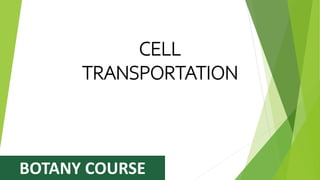
CELL TRANSPORTATION.pptx
- 2. Cell
- 3. Cell Transport Cell transport is the movement of substances across the cell membrane either into or out of the cell.
- 4. Cell Membrane The cell membrane, also known as the plasma membrane, is a double layer of lipids and proteins that surrounds a cell. It is a selectively permeable barrier, meaning it allows some substances to cross, but not others. Like a drawbridge intended to protect a castle and keep out enemies, the cell membrane only allows certain molecules to enter or exit.
- 5. Phospholipids are lipid molecules made up of a phosphate group head and two fatty acid tails. It is a molecule that forms the characteristic- double layer of the plasma membrane. Phospholipid Bilayer
- 6. 1.Passive Transport •Simple Diffusion • Facilitated Diffusion •Osmosis 2.Active Transport •Sodium-Potassium Pump •Endocytosis •Exocytosis Types of Cell Transport
- 7. What is Passive Transport? Passive transport occurs naturally, as substances move down a concentration gradient in the absence of energy. Therefore, the primary difference in active transport vs passive transport is the energy requirement.
- 8. Types of Passive Transport • Simple Diffusion A process of diffusion that occurs without the aid of an integral membrane protein. Allows substances to pass through cell membranes without any energy. • Facilitated Diffusion A process that occurs when molecules or ions pass through a cell membrane with the assistance of an embedded transport protein.
- 9. Types of Passive Transport • Osmosis Osmosis is when a substance crosses a semipermeable membrane in order to balance the concentrations of another substance. In biology, this is usually when a solvent such as water flows into or out of a cell depending on the concentration of a solute such as salt.
- 10. Types of Osmosis Solutions • Hypotonic Solution • Hypertonic Solution • Isotonic Solution
- 11. Types of Osmosis Solutions • Hypotonic Solution Hypotonic solution, there is a higher concentration of solutes inside the cell than outside the cell. When this occurs, more solvent will enter the cell than leave it to balance out the concentration of solute. Example: Plant cells need more water than animal cells. • Hypertonic Solution Hypertonic solution is the opposite of a hypotonic solution; there is more solute outside the cell than inside it. In this type of solution, more solvent will exit the cell than enter it in order to lower the concentration of solute outside the cell
- 12. Types of Osmosis Solutions • Isotonic Solution Isotonic solution has the same concentration of solutes both inside and outside the cell. For example, a cell with the same concentration of salt inside it as in the surrounding water/fluid would be said to be in an isotonic solution. Under these conditions, there is no net movement of solvent; in this case, the amount of water entering and exiting the cell’s membrane is equal.
- 14. What is Active Transport? Active transport moves substances from a region of lower concentration to a higher concentration, i.e., against the concentration gradient. There is an energy requirement for this process, as it does not occur naturally in the absence of active forces.
- 15. Types of Active Transport • Sodium - Potassium Pump The ability of the sodium-potassium pump to transport potassium into cells while transporting sodium out of cells is so important that some estimates suggest we spend a total of 20-25% of all the energy we get from food just performing this one task! In neurons, a great majority of the cell’s energy is used to power sodium-potassium pumps.
- 16. Types of Active Transport • Endocytosis Endocytosis, a cell “eats” something by wrapping and re-forming its membrane around the substance or item. It then “pinches off” to form a small sphere of membrane called a vesicle that contains the molecule and transports it to wherever it will be used in the cell.
- 17. Types of Active Transport • Exocytosis Exocytosis, a cell moves something outside of itself in large quantities by wrapping it in a membrane called a vesicle and “spitting out” the vesicle. This most commonly occurs when a cell wants to “export” an important product, such as cells that synthesize and export enzymes and hormones that are needed throughout the body.